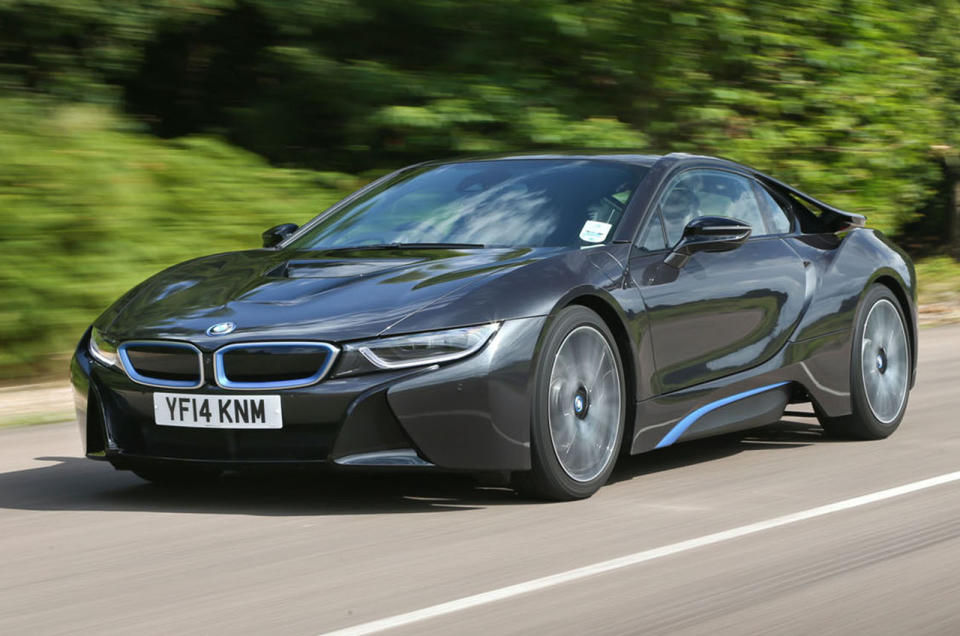Used BMW i8 2014-2020 review

When it arrived in 2014, the BMW i8 arrived like a bolt from the blue.
When it went off sale in 2021 it left us open-mouthed and still reeling from the shock, unable to work out if this butterfly-doored, low-slung and extravagantly constructed plug-in hybrid sports car was the Great Leap Forward or a slightly underwhelming Porsche 911 rival, with its six-figure price tag and the engine from a Mini Cooper.
Where it unquestionably succeeded, though, is with its Blade Runner-aping design. The i8 remained recognisably a BMW, but it didn’t look a lot like any other cooking BMW.
It looked (and still looks) terrific, and time and depreciation being what they are, you can now put one on your driveway for not much more than £30,000 – and you’re very unlikely to see its price go lower. So it’s an exotic investment, then?
Could be… Underneath its extravagant exterior, the i8 mixed a combustion engine, an electric motor and a lithium ion battery pack. It could run, in the earlier cars, for up to 23 miles on electric-only power (postfacelift models upped this to 34 miles) and claimed an official NEDC fuel consumption figure of 135mpg.
At its heart, that engine is, as mentioned, a reworked version of the 1.5-litre turbocharged petrol triple you will find in a Mini Cooper, but special internals and clever induction technology conjure 228bhp and 236lb ft.
The transversely mounted mid-engined powerplant drives not only the rear wheels via a six-speed automatic transmission but also a high-output starter-generator electric motor, which shuffles power back into the 7.1kWh battery under the floor. Up front, there’s a 129bhp, 184lb ft electric motor driving the front wheels.
Peaked combined outputs are 357bhp and 420lb ft. The weight of the i8 was initially a claimed 1560kg, which is about the same as a contemporary 911 and noticeably less than a Jaguar E-Type.
Performance was listed at 0-62mph 4.4sec and with a top speed of 155mph. The powertrain is willing and flexible, too. The low-profile yet relatively narrow tyres and super-stiff structure create a bit of roar, but you can still cover long distances at effortlessly high speeds in this car.
And when you do, it’s remarkable how economical the i8 can be: out on the open road you will seldom get less than 40mpg, and should see more if you plug it in regularly and your journeys are short.
Of course, if you approach the i8 hoping for a shrapnel-spitting rival to the likes of a Porsche 911 or Audi R8, you’re likely to come away disappointed.
In essence, it’s really a grand tourer and as such feels more like BMW’s own 6 Series coupé range, with steering that is light, responsive and accurate without the drama of some of its sportier rivals.
The chassis, too, is beautifully damped, and it’s supremely well matched to the powertrain - the i8 really is a lovely thing to drive.
Some complained that it didn’t have enough character, but it is not for a car to have character, but for its driver to have it. Punt it down your favourite road and you will find the i8 is an immensely and easily enjoyable thing and a surprisingly south car - unlike many of its rivals.
BMW i8 2014-2020 common problems
Engine: The engine is based on the 1.5-litre unit in the Mini Cooper. So it’s reliable and the six-speed automatic gearbox is robust. There have been issues with the fuel pressure sensor, which is prone to failure. One or two owners have reported engine failure, but the vast majority noted excellent reliability. Warnings of a low coolant level when the levels are correct suggest a sensor issue. There have also been reports of problems with overheating and a few complaints about the central controller.
Brakes: Most parts prices for an i8 can be expensive, but consumables are generally okay. For instance, front brake pads should cost you no more than those for a 3 Series.
Body: As a sports car with a six-figure price when new, the i8 is the kind of model that owners tend to cherish. Even so, it’s worth checking the wheels for scrapes and scratches, looking for bodywork damage (particularly around the doors, which require a lot of space to open) and ensuring the tyres are in good condition.
Many owners find the butterfly doors can be a pain. The door struts have been known to fail and cost a lot of money to repair, so check carefully when buying. Some fuel tank covers have been sticky too, refusing to open.
Electrics: While some owners have had to return their i8s to dealers to address warning lights, it tends to be for isolated cases rather than faults that are common to i8s. Software issues are not uncommon, though, so check the service and MOT history carefully.
Recalls: There have been five recalls. Cars built in 2014 had a possible fuel leak; i8s built in 2015 had a faulty sensor that could cause stability issues; cars built in late 2016 could have an airbag fault; i8s were recalled in 2019 to replace a faulty printed circuit board; and in 2020 an issue with impurities in the high-voltage batteries was addressed.
]]>

 Yahoo Autos
Yahoo Autos 